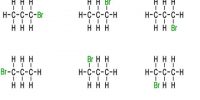The ionization energy decreases with the increasing size of atom. The larger the size of atom, lesser is the ionization energy. This is due to the fact that electrons are tightly held in smaller atoms whereas in large atoms, electrons are held quite loose, i.e., lesser energy is required for removal of electrons from larger atoms than the smaller one. Hence ionization energy is lower for larger atoms and higher for smaller atoms.
Example: 1
The I.E of Be (At. No.4) is greater than that of Li (At. No.3) because the nuclear charge of Be (Z=4) is greater than Li(Z=3). Higher the nuclear charge, greater would be the force of attraction between nucleus and outermost electron.
Hence, the first I.E. of Be is than that of Li.
Example: 2
The I.E. of Be is more than that of B though the nuclear charge of boron atom (Z=5) is greater than that of beryllium atom (Z = 4). This can be explained as follows:
Boron atom (Z = 5; 1s2 2s2 2px1 2py0 2pz0) is having one unpaired electron in the 2p-subshell. Be-atom (Z = 4; 1s2 2s2) is having paired electrons in the 2s-subshell.
As the fully filled 2s-subshell in Be-atom is more stable than B-atom due to symmetry, more energy would be needed to remove an electron from Be-atom. Hence, Be has high I. E.













